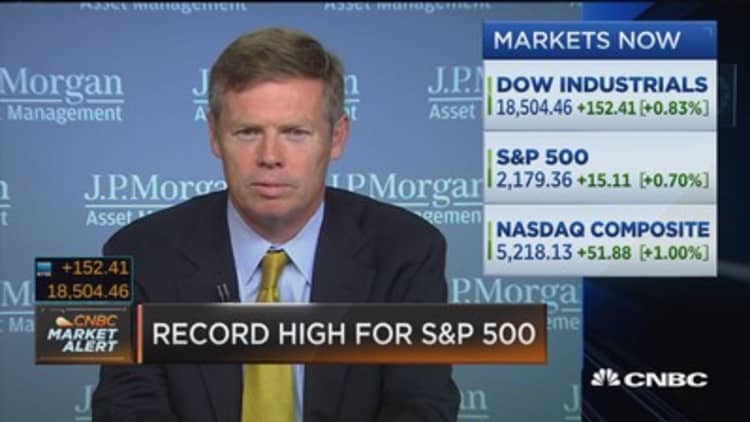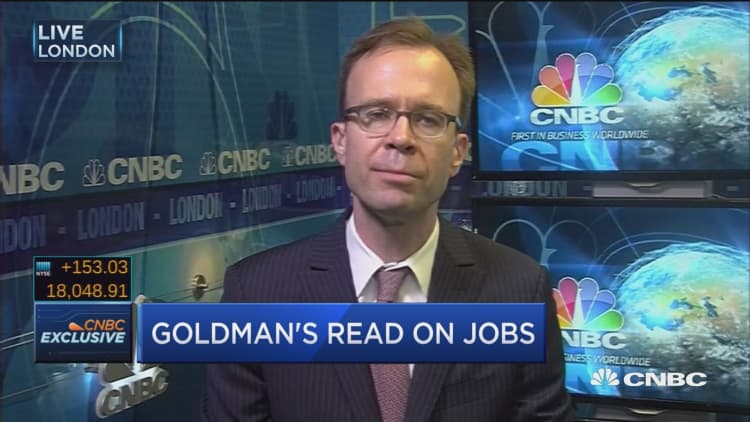


The jobs report on Friday didn't just blow away expectations by adding 255,000 positions, but was strong throughout, the Republican former chief economist of the President's Council of Economic Advisers said.
"We have rarely gotten a report that didn't have some hole, like you get jobs but there's no wage growth, or the labor forces declines and the unemployment goes down for the wrong reason," said Douglas Holtz-Eakin, who served under President George W. Bush.
The Labor Department reported unemployment was unchanged at 4.9 percent in July, while the labor force participation rate ticked up slightly and hourly wages rose by 8 cents, a 2.6 percent annualized gain.
Additionally, productivity was essentially flat, making the report look clean, said Holtz-Eakin, now president of the American Action Forum.
"This is strong across the board. I don't think there's a bad number in here," he told CNBC's "Squawk Box."

Job gains over the last three months through July averaged 190,000, a slowdown from last year.
However, the United States only needs to add about 80,000 jobs per month to keep the unemployment rate steady, said Jason Furman, chairman of President Barack Obama's Council of Economic Advisers.
"The reason we were creating so many jobs last year and the year before, was because we still had a high unemployment rate and we needed to bring it down. As the unemployment rate gets lower, the number of jobs we need to keep our economy strong is going to be a little bit lower," he told CNBC's "Squawk on the Street."
Jeff Madrick, a fellow at The Century Foundation, said the report is "about the best news we could expect."
"It suggests the economy is not stalling, it's coming back. A stronger expansion is possible. It doesn't mean it's a shoe-in," he told "Squawk Box."

Bill Rodgers, a former Labor Department economist, said he believes it is important to focus on human priority expenditures as a means of sustaining long-term growth within the U.S. job market.
Rodgers told CNBC's "Power Lunch" the next step begins with both the public and private sectors investing not only in human capital but also in social capital.
In addition to focusing on physical infrastructure, "we also need to focus on human infrastructure. There's been a great deal of deferred investment in those two areas," said Rodgers, who linked such investments to long-term productivity growth.
In Madrick's view, the data could create confidence among U.S. businesses that have been paring back capital spending.
However, David Malpass, a newly announced senior economic advisor to Donald Trump, told CNBC the job gains was not a sign that the economy is fixed.
Holtz-Eakin said he sees little growth upside for the U.S. economy without renewed business investment. A third month of strong job gains after the U.S. added more than 200,000 jobs in both June and July would lend some evidence that the economy can grow on the back of the labor market despite moribund capital spending, he said.
The U.S. economy grew just 1.2 percent in the second quarter, a preliminary reading of GDP data showed last week. That fell well below expectations for 2.6 percent growth and put the average growth rate for 2016 at just 1 percent.

Deutsche Bank Chief U.S. Economist Joseph LaVorgna said the jobs report doesn't change his bearish view on the economy. He, too, cited weak business investment, saying the economy is unbalanced and growth is being led almost solely by the consumer.
The GDP data last week showed government spending, fixed investment and inventories all fell.
"The strong employment numbers mean productivity is very soft, and corporate profit margins are therefore under further pressure, so this is not a long-term sustainable phenomenon," LaVorgna told "Squawk on the Street."
"Maybe we can get back to 2 percent growth, but boy, it seems like we've got a lot we could worry about and should worry about," he said.
David Kelly, chief global strategist at JPMorgan Asset Management, said that outlook is too pessimistic. The critical factor underpinning the last year of middling GDP growth was a "huge" inventory correction.
"Inventories were now shrinking in the second quarter. That means that going from here, for the next year, inventory growth will actually add to economic growth. So I think the clouds are basically clearing here in terms of the inventory correction, worries about Brexit, other issues," he told "Squawk on the Street."
Kelly said the U.S. economy will likely ramp up to 2 percent this year and into 2017, providing enough evidence to the Federal Reserve that it can finally begin raising interest rates again, setting up two rate hikes this year.
The central bank has not raised rates since an initial quarter-point hike in December.

Goldman Sachs raised its probability of a September rate hike to 1 in 3, said Jan Hatzius, the firm's chief economist.
"The odds are against, but by less than before today's report," he told CNBC's "Squawk on the Street."
As for the impact on the broader economy, Hatzius warned that GDP numbers are "noisy" and U.S. analysts have the benefit of a number of high-quality, high-frequency indicators that, taken together, give a better read on the economy than the GDP numbers.
Goldman's composite indicator that summarizes weekly readings rose to 2.3 percent in July and has been gaining traction in recent months, he said.
Hatzius acknowledged that corporate margins have grown weaker, but said it was largely due to the decline in energy prices. He further noted that the oil price rout provides an offsetting benefit to consumers, who pay less for fuel.
"If you only focus on the negative impact of this basically distributional shift on the corporate sector and ignore the positive impact on the household sector, you're missing part of the picture in my view," he said.


